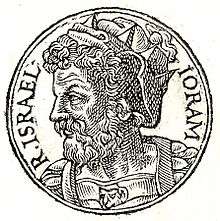Jehoram of Israel
| Jehoram | |
|---|---|
| King of Israel | |
 Jehoram from Guillaume Rouillé's Promptuarii Iconum Insigniorum | |
| Predecessor | Ahaziah of Israel |
| Successor | Jehu |
Jehoram (Hebrew: יְהוֹרָם Yəhōrām; also Joram) was a king of the northern Kingdom of Israel. (2 Kings 8:16, 8:25–28) He was the son of Ahab and Jezebel, and brother to King Ahaziah.
According to 2 Kings, 8:16, in the fifth year of Joram of Israel, (another) Jehoram became king of Judah, when his father Jehoshaphat was (still) king of Judah, indicating a co-regency. The author of Kings speaks of both Jehoram of Israel and Jehoram of Judah in the same passage, which can be confusing.
Reign
Joram began to reign in Israel in the 18th year of Jehoshaphat of Judah, and ruled 12 years. (2 Kings 3:1) William F. Albright has dated his reign to 849–842 BC, whereas E. R. Thiele proposed 852–841 BC.[1]
Unike his predecessors, Joram did not worship Baal, but followed in the ways of Jeroboam son of Nebat who led the Israelites to sin. With Jehoshaphat of Judah, Jehoram attacked Mesha, King of Moabites. In the war between Aram-Damascus and Israel, Elisha befriended Joram, revealing to him the plans of the enemy. Subsequently, when Ben-hadad besieged Samaria, reducing the city almost to starvation, Joram sought to kill the prophet. The latter, however, foretold that a period of plenty was imminent; the siege was soon lifted, the city's food supplies were replenished, and the old relation between the king and the prophet was restored.[2]
When Hazael, king of the Aram, revolted in Damascus, as Elisha had predicted (2 Kings 8:12), Jehoram made an alliance with his nephew Ahaziah, King of Judah. The two kings set forth to take Ramoth-gilead from Aram. The battle failed; Joram was wounded in the fighting, and he withdrew to Jezreel to recover. It is likely that his defeat at Ramoth-Gilead was a disaster. As a result, while Joram was recuperating at Jezreel, his general, Jehu, incited a revolt. Jehu executed Joram by shooting him in the back with an arrow, and had his body thrown into the field of Naboth the Jezreelite, as punishment for his parents sin in illegally stealing Naboth's land. With the death of Joram and his other family members, the Ahab Dynasty came to an end. Jehu claimed the throne of Israel as his own.
The author of the Tel Dan Stele claimed to have slain both Ahaziah and Jehoram. Hazael is the most likely to have written it.[3]
References
- ↑ Edwin Thiele, The Mysterious Numbers of the Hebrew Kings, (1st ed.; New York: Macmillan, 1951; 2d ed.; Grand Rapids: Eerdmans, 1965; 3rd ed.; Grand Rapids: Zondervan/Kregel, 1983). ISBN 0-8254-3825-X, 9780825438257
- ↑ "Jehoram", Jewish Encyclopedia
- ↑ http://theosophical.wordpress.com/2011/07/15/biblical-archaeology-4-the-moabite-stone-a-k-a-mesha-stele/
| Jehoram of Israel | ||
| Regnal titles | ||
|---|---|---|
| Preceded by Ahaziah |
King of Israel 852–841 BC |
Succeeded by Jehu |